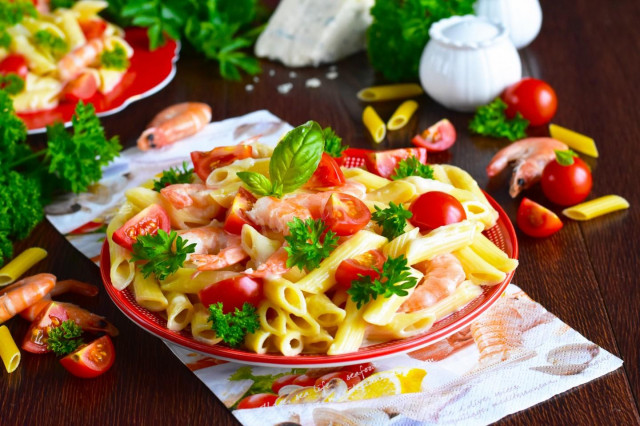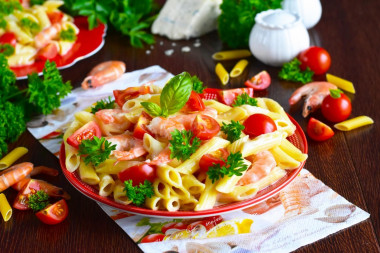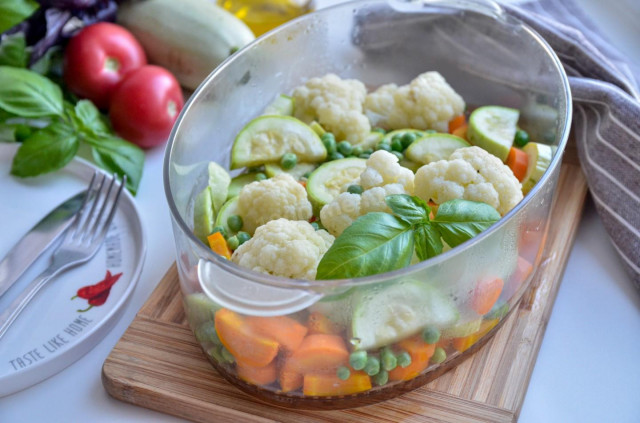Composition / ingredients
Step-by-step cooking
Step 1:
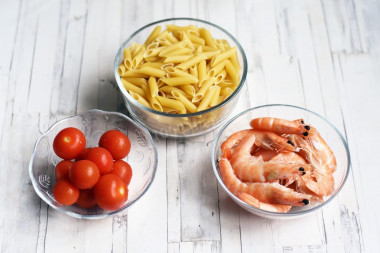
How to make pasta with shrimp in cream sauce? Very simple! First, prepare the necessary ingredients according to the list. You can take any pasta, long (spaghetti, fettuccini) or short (bows, penne, horns, etc.). I have penne.
Step 2:
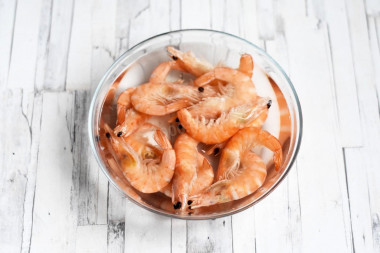
Pour boiling water over the shrimp and leave for 25-30 minutes. Shrimps are usually sold already boiled and frozen. It's easy enough to defrost them, but you don't need to boil them specially.
Step 3:
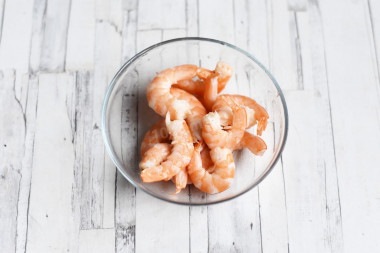
Then peel the shrimp from the head and shell. If the shrimp are very large, you can cut them in half. You can take any shrimp: ordinary, royal or even larger - Argentine. Both purified and uncleaned. The net weight of peeled shrimps should be at least 200 g. Therefore, if you take unpeeled frozen shrimps with your head, then you need to take them about 1.5-2 times more.
Step 4:
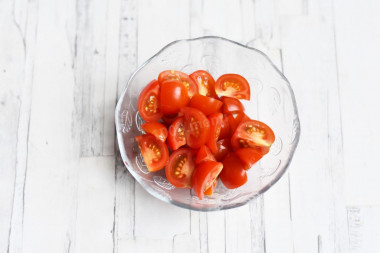
Wash cherry tomatoes, dry and cut into quarters. I used cherry tomatoes, but you can also take the usual strong juicy tomatoes. Soft fruits do not keep their shape well, in the process of slicing and cooking they will spread into a shapeless mass and spoil the appearance of the dish.
Step 5:
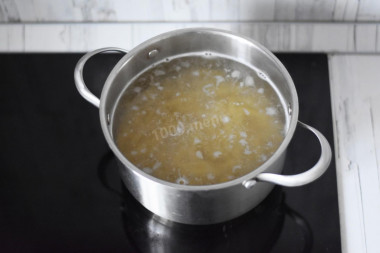
Boil the pasta in a large amount of salted boiling water until al dente (one minute less than indicated on the package).
Step 6:

While the pasta is cooking, quickly prepare the sauce. You can take cream of any fat content, but the fatter the cream, the tastier the sauce will be. I have cream with a fat content of 33%. Take any cheese. Parmesan and mozzarella are ideal, but you can also use ordinary cheese like Russian or Gouda, as long as it melts well and is delicious.
Step 7:

Grate the cheese on a fine grater.
Step 8:
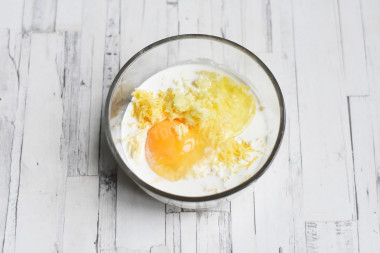
In a bowl, combine the egg, cream, grated cheese, garlic and salt passed through the press.
Step 9:

Beat everything with a mixer until smooth. The sauce is ready.
Step 10:
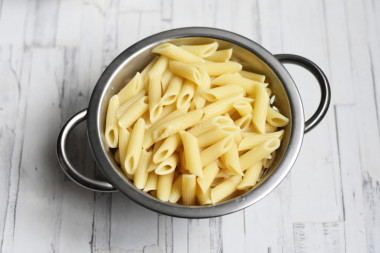
Put the finished pasta in a colander and let the water drain. Then return the pasta to the pan in which they were cooked.
Step 11:
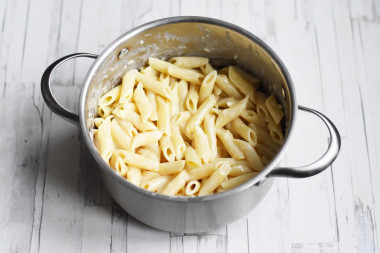
Pour the cream sauce into the pasta and mix quickly. The cheese in the sauce will begin to melt and envelop all the pasta. If you want more sauce, you can increase its amount by 1.5-2 times.
Step 12:

At the end, add the peeled shrimp and mix again.
Step 13:
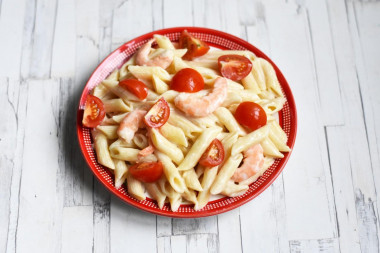
Arrange the hot pasta with shrimp on plates. Spread the tomato slices on top.
Step 14:

Sprinkle the dish with herbs and serve immediately. Bon appetit!
How to cook pasta properly, how to cook pasta al dente, how to choose a quality product to avoid disappointment and much more read in the article "Pasta and pasta - the subtleties of choice and secrets of cooking" .
Cream for this recipe can be of any fat content, but remember that the higher the percentage of fat content of the products you use, the higher the calorie content of the dish will be.
Cream can be replaced with sour cream.
Caloric content of products possible in the composition of the dish
- Canned shrimp - 81 kcal/100g
- Boiled shrimp - 95 kcal/100g
- Shrimps peeled frozen - 60 kcal/100g
- Fresh shrimp - 97 kcal/100g
- Tomatoes - 23 kcal/100g
- Buttermilk - 36 kcal/100g
- Cream of 20 % fat content - 300 kcal/100g
- Cream of 10% fat content - 120 kcal/100g
- Cream - 300 kcal/100g
- Chicken egg - 157 kcal/100g
- Egg white - 45 kcal/100g
- Egg powder - 542 kcal/100g
- Egg yolk - 352 kcal/100g
- Ostrich egg - 118 kcal/100g
- Pasta, premium, fortified - 337 kcal/100g
- Pasta, premium, dairy - 309 kcal/100g
- Pasta, premium grade, egg - 342 kcal/100g
- Pasta made from flour of the 1st grade - 333 kcal/100g
- Pasta made of flour in / with - 338 kcal/100g
- Boiled pasta - 135 kcal/100g
- Pasta - 338 kcal/100g
- Dutch cheese - 352 kcal/100g
- Swiss cheese - 335 kcal/100g
- Russian cheese - 366 kcal/100g
- Kostroma cheese - 345 kcal/100g
- Yaroslavsky cheese - 361 kcal/100g
- Altai cheese 50% fat content - 356 kcal/100g
- Soviet cheese - 400 kcal/100g
- Cheese "steppe" - 362 kcal/100g
- Cheese "uglichsky" - 347 kcal/100g
- Poshekhonsky cheese - 350 kcal/100g
- Lambert cheese - 377 kcal/100g
- Appnzeller cheese with 50% fat content - 400 kcal/100g
- Chester cheese with 50% fat content - 363 kcal/100g
- Edamer cheese with 40% fat content - 340 kcal/100g
- Cheese with mushrooms of 50% fat content - 395 kcal/100g
- Emmental cheese with 45% fat content - 420 kcal/100g
- Gouda cheese with 45% fat content - 356 kcal/100g
- Aiadeus cheese - 364 kcal/100g
- Dom blanc cheese (semi-hard) - 360 kcal/100g
- Lo spalmino cheese - 61 kcal/100g
- Cheese "etorki" (sheep, hard) - 401 kcal/100g
- White cheese - 100 kcal/100g
- Fat yellow cheese - 260 kcal/100g
- Altai cheese - 355 kcal/100g
- Kaunas cheese - 355 kcal/100g
- Latvian cheese - 316 kcal/100g
- Limburger cheese - 327 kcal/100g
- Lithuanian cheese - 250 kcal/100g
- Lake cheese - 350 kcal/100g
- Gruyere cheese - 396 kcal/100g
- Garlic - 143 kcal/100g
- Salt - 0 kcal/100g

